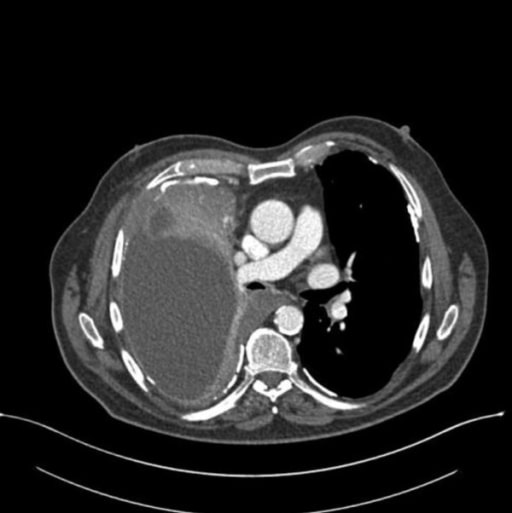Playlist
Show Playlist
Hide Playlist
Mesothelioma: Presentation and Management
-
Slides 07 LungCancer Tumors and Metastases Neoplasias RespiratoryAdvanced.pdf
-
Download Lecture Overview
00:01 So we've now discussed lung cancer which is the commonest fatal cancer that affects any humans. 00:07 There is another cancer of the thoracic cavity which is also very important but only in a selected group of patients and that’s the mesothelioma. This is a primary malignant tumour of the mesothelium. It occurs due to asbestos exposure. So people who have worked with asbestos or breathing the asbestos fibers. Asbestos is a mineral that was used a lot because it has heat proof and fire proof properties. However the fiber that it's made of are very easily inhaled and once they reach the lungs they can work their way through the alveoli and eventually they work their way through to reach pleura and over time they cause inflammation of the pleura and eventually in some people that will develop into a cancer called a mesothelioma. 01:00 So the striking thing about mesothelioma is that it has a lag phase from exposure of asbestos of about 20 to 40 years. So the patient’s exposure occurred sometime before they present with the disease. This means the mesothelioma is disease that affects people who have worked with asbestos and that tends to be middle aged men who worked in building industries, dockers, engineers, ship builders, boiler makers. These are all industries that used to in the old days use asbestos a lot. The dose of asbestos exposure is related to the risk of mesothelioma. So the higher the dose the more chance you have developing mesothelioma. 01:44 But it is never a certainty. Most people who worked at asbestos don’t develop mesothelioma. 01:55 Almost everyone who presents with mesothelioma has worked with asbestos thing and therefore identified while if you talked to the patient about their occupational history. 02:03 How does it present? Early mesothelioma presents as an exudative pleural effusion, so breathlessness. 02:15 But actually its frequently associated with chest wall pain. It's quite hard to describe chest wall pain which is diffused over one side of the chest and the patient may have the systemic symptoms that you often get with cancer a weight loss and general malaise. 02:27 As the cancer develops the radiology becomes more and more distinctive and this is associated with extensive pleural thickening and that constricts the lungs. So you get a lot of lung volume loss as well. So you can see here on the chest X-ray that there is a right-sided pleural changes with thickening going up the side of the chest and in fact if you look at the volume of that right lung in chest X-ray, you see that it looks a lot less than the volume of the left lung. You can see that even better on the CT scan image where the circumferential thickening around the right lung and the inside of it, the lung tissue, is only about half the volume of the right side. That is due to the mesothelium cancer cells spreading along the pleura growing throughout, is a sheath like cancer enclosing that lung and preventing it from normally to expand. So you need to think about mesothelioma in patients who have worked with asbestos and who present with pleural effusions especially if it is a painful pleural effusion. But to diagnose it you need biopsies and that requires a CT-guided or ultrasound-guided biopsies of the pleura. Unfortunately the biopsies in the cells are quite difficult to interpret and quite often have to be repeated to get a confirmed diagnosis. The disease itself is almost impossible to cure and treatment is aimed at palliation. 03:58 So if somebody presents with a large effusion and breathlessness as a consequence of that, you can drain the fluid off and then you can prevent the effusion from reforming by doing a pleurodesis, a fusing of the visceral and parietal pleura, probably best done by a surgical operation. 04:13 Patients with pain will get palliative radio therapy and if you got a mass, because sometimes it happens in the mesothelium erodes for the chest wall that also will require palliative radio therapy. There are chemotherapy agents that are used for mesothelioma which seem to have some effect where none of them have had a dramatic effect. 04:34 Pain control is vital, so opiate painkillers will be necessary and unfortunately the pain is quite difficult to control even with opioid pain killers. The median survival for mesothelioma is about a year. It’s not long.
About the Lecture
The lecture Mesothelioma: Presentation and Management by Jeremy Brown, PhD, MRCP(UK), MBBS is from the course Lung Cancer.
Included Quiz Questions
Which of the following statements regarding mesothelioma is FALSE ?
- Mesothelioma is a benign tumor of the pleura.
- The higher the dose and longer the duration of asbestos exposure, the more elevated the risk of mesothelioma development.
- The size and structure of the asbestos fibers determines the level at which it becomes trapped in the lung parenchyma.
- Mesothelioma is the primary tumor of the mesothelium lining the pleura.
Which of the following is NOT an occupation in which asbestos is utilized?
- Pest control worker
- Plumber
- Ship wrecker
- Docker
Which of the following is NOT usually part of the management of mesothelioma?
- A circumferential mesothelioma is commonly cured by surgical resection.
- Most patients with mesothelioma will require palliative therapy.
- Pleurodesis can help prevent malignant pleural effusions.
- CT-guided or thoracoscopic biopsy is required for diagnosis.
- CT scans and X-rays help in the initial assessment of mesothelioma.
Customer reviews
5,0 of 5 stars
| 5 Stars |
|
5 |
| 4 Stars |
|
0 |
| 3 Stars |
|
0 |
| 2 Stars |
|
0 |
| 1 Star |
|
0 |




